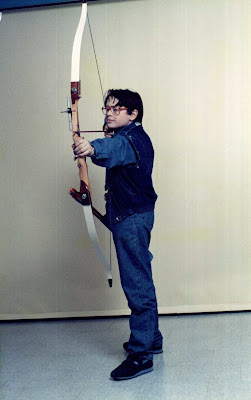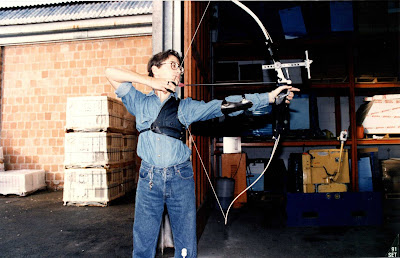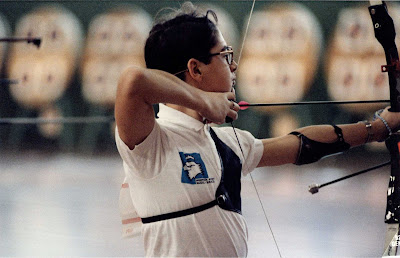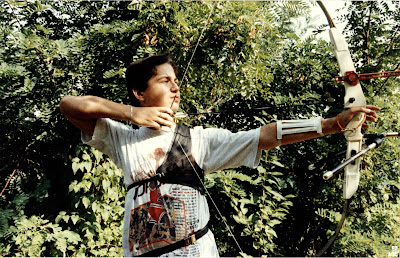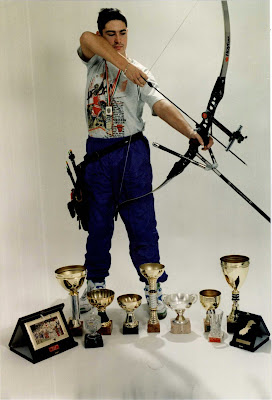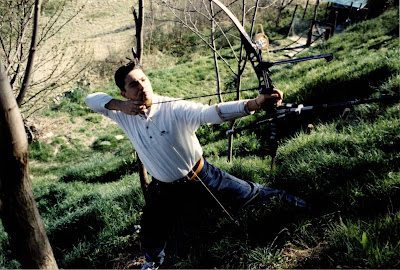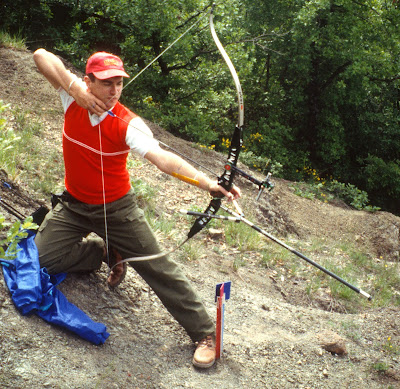I began archery in January of 1990, at the age of 11.
Just after the first course I, as others, wanted to buy my own equipment but I was not allowed to do so. In fact, my teacher, seeing I had a passion for archery, decided to lend me a practice bow in order to make me save some money and get a more serious bow later on.
And therefore, I was able to get some bow-thing at home, and that has been a real boost in my archery passion.
A few months later it came the time for me to get a real bow: a black Samick SMT-7. That was essentially the same model as the more famous Browning SMT-7. I have to say my father bought me a whole equipment, ranging from the quiver (the first and only field quiver I ever had), the case, arrows, sight (a black T shaped model) and a central stabilizer (rod).
Approaching the Giochi della Gioventù my trainer lent me a more professional sight, to which I attached the clicker since I was using too much long arrows (another little trick in order to let my shoulders grow...).
After the Giochi della Gioventù I got also an Hoyt tunable v-bar, color gold, to which I attached two metal bars. I got also a new sight, a red Spigarelli (Spiga 30 if I remember well).
Then was the time for the greatest bow I ever had: an Hoyt TD/4 (the top riser at that time). My model was a second-hand, and therefore it was a little different from the model of that year, most notably it was frosted.
Before my first FITA competition of the 1992 season, my father drove me to the local archery shop and bought me a new ACE SS full stabilizing system, and the very next day I placed it into the bow directly on the field of the competition. That day I made my personal own record and started being of interest for many other trainers.
During that season I also changed the sight from the Spigarelli to the AGF Safari, a carbon-only sight with an inverse-T design.
With such equipment I got my first bronze medal at the national championships.
In 1993, stupidly, I ask my father to buy me another riser, another TD/4. I asked for having it black, my favorite color, but my father insisted to take it with another color, and so the last choice was deeper blue (essentially a light black). I hated such bow with a passion, I don't remember me getting any decent score with such bow.
In 1994, around Christmas, my father decided to buy me the second best bow I ever had: the Hoyt Radian.
It was a very innovative model, even if the idea of a milled riser was not new and we had already an Italian manufacter (Spigarelli, that at that time had produced two models), but, hey, that was the bow with which Andrea (Parenti) did win his second World Championship.
Three radians where available on the local archery shop: a blue one, a black one and a green one. You can imagine which one did I pick, can you?
If I remember well, the price for such a riser was 900.000 £, that is around 450 € while the TD/4 riser was half the price. It was the more expensive riser I've ever had.
Please note that I'm talking about the very first commercial model of the Radian, the one without the bushings for the rods and with those little bars as a front stop for the tiller adjustment.
With that riser I got my second individual bronze medal and a few team medals at the national championships.
In 1995, since I was doing a lot of archery, I was trying to replicate my equipment in seek of redundancy, and one piece I lack was the riser itself, and so I got another Radian. This time it was the "recent" version, meaning it had the bushings and the numbers in the pocket limbs. Horribly, it was colored in red (or better, magenta).
After a few months of training, I had given it back to the local archery shop exchanging it for other material.
After the Olympia games of the 1996 and the great impression of Justin Huish and his Hoyt Avalon, I bought an Avalon, giving back my black Radian.
Yes, it was a huge mistake.
Yes, it was bigger than huge, it was a stupid thing.
I have to say that the Avalon was a great riser, with a lot of interesting ideas borrowed (I suspect) from the PSE Centra, including the tilt of the limb pockets, two (fixed) positions for the button berger, a good design but a stupid big handle (similar to that of the TD/4).
After a summer of shooting, mine as much others revealed a crack just under the top limb pocket.
My father, able as usual, convinced the local archery shop to get it back and exchange it with a much more solid and well known Radian; the only condition was I had to accept the color, that was again that stupid and horrible magenta-red.
And so I did have a Radian again.
But the color was so horrible.
I hated such color.
And luckily, a few years after, me and a friend of mine were able to change color (do you remember it was an anodized riser, do you?), and guess what? I went for a black color.
The result was amazing: I got a black frosted Radian, something nobody else did have (and still do). The final result was like having it made of the same material of a barrel of a gun.
Today, that is still the riser I own and be sure for a thing: I'm not going to sell it.
I did not win anything with that, I did not get any personal record, but it has all the main features of my greatest bow ever: it is a Radian and it is frosted.
And yes, I blame myself for having sold either the white TD/4 and the first radian!
